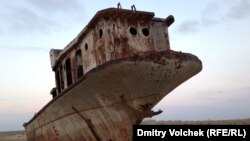Once, long ago, the Amu-Darya, one of Central Asia's two great rivers, emptied into the Caspian Sea. There is still evidence of the "Uzboy" canal system in what is now southwestern Turkmenistan and indications that some 4,000 years ago it was a rich agricultural area. Now it is just a desert and there are concerns that mismanagement of water resources and climate change could transform other parts of Central Asia into desert lands.
The region's population is roughly 10 times the size it was just 100 years ago, many of the same policies that led to the desiccation of the Aral Sea are still in place, the glaciers in the mountains to the east are melting at an alarming rate, and the effects of climate change are increasingly evident.
RFE/RL's Turkmen Service, known locally as Azatlyk, assembled a panel discussion (majlis) to review the water situation in Central Asia and neighboring states, examine regional water-supply forecasts for 35, 50, or 100 years from now, and consider whether water could be cause for conflict there.
Azatlyk Director Muhammad Tahir moderated the panel. Participating in the discussion from Iran was Kaveh Madani, an expert in global water issues from the Imperial College in London, and Ryskeldi Satke, a Bishkek-based journalist who has been investigating the recession of Central Asia's glaciers and the causes of this process. And I had a few things to say also.
Satke started the discussion by citing figures from recent studies that showed that glaciers in the Tien-Shan Mountains in Central Asia "lost 27 percent of their total mass over the last 50 years" and that, by the year 2050, "the remaining ice in the Tien-Shan glaciers could be lost further."
Satke, who has written several articles on how the Kumtor gold-mining project in Kyrgyzstan has negatively affected a nearby glacier, pointed out that the problem of receding glaciers is not unique to Central Asia. He said that in "Afghanistan and Pakistan, 93 percent of the glaciers there [are] retreating the same way."
Madani drew attention to Lake Orumieh (Urmia) in Iran and noted similarities with Central Asia.
"What we are seeing in Lake Urmia was the Aral Sea syndrome, [and] Lake Urmia is not the only one. We're seeing this [syndrome] happening in many, many places."
Madani noted, though, that this syndrome is the product of mismanagement, not climate change.
"The Aral Sea is probably the classic example of mismanagement and man-made disaster but we're seeing this elsewhere. The problem is in the developing world."
It is still unclear how bad the situation is. Studies are being done now in some of the affected countries of inner Asia, but Satke recalled these studies only resumed relatively recently.
"After the '90s, when the Soviet state collapsed, for about two decades, for close to 15 years, there were no activities," he said. As a result, regarding the situation in Central Asia, there is only data from the Soviet period and roughly the last five years.
Even without comprehensive data, however, it is evident that a dire predicament exists, and that there is no immediate way out. It was noted during the discussion that Central Asia's population has risen from some 6 to 8 million at the start of the 20th century to some 66 million today. One of the main causes of the drying out of the Aral Sea was the irrigation of Central Asian land, particularly former colonial master Russia's decision to make the region Moscow's cotton plantation. Cotton is still a vital part of state revenue for most of the current Central Asian governments, particularly Uzbekistan, though the plant requires a huge amount of water.
Added to all this are the creeping effects of climate change. Madani and Satke both said it is too early to tell how many of the current problems are the result of climate change, though unusual heat this summer in Central Asia and floods in Kazakhstan, Kyrgyzstan, and Tajikistan could be indications of such a process.
Uzbek President Islam Karimov suggested in September 2012 that a scarcity of water could be reason for future regional wars. It already has been the source of conflict among small communities along the Kyrgyz-Tajik border.
But Madani cautioned that, to date, "we have never had in history two nations fighting over water." But he added that water has been mixed into a basket of grievances that have started wars. More optimistically, Madani said history shows there can be cooperation on water issues and such cooperation is not based on the style of governance between affected states -- even the despot can cooperate with the democrat over water issues.
These issues concerning water and its use in Central Asia were discussed in greater depth during the roundtable, as were other topics, such as the push for hydropower plants in mountainous Kyrgyzstan and Tajikistan or the possibilities for a regional approach to the growing problem.
An audio recording of the discussion can be heard here:








